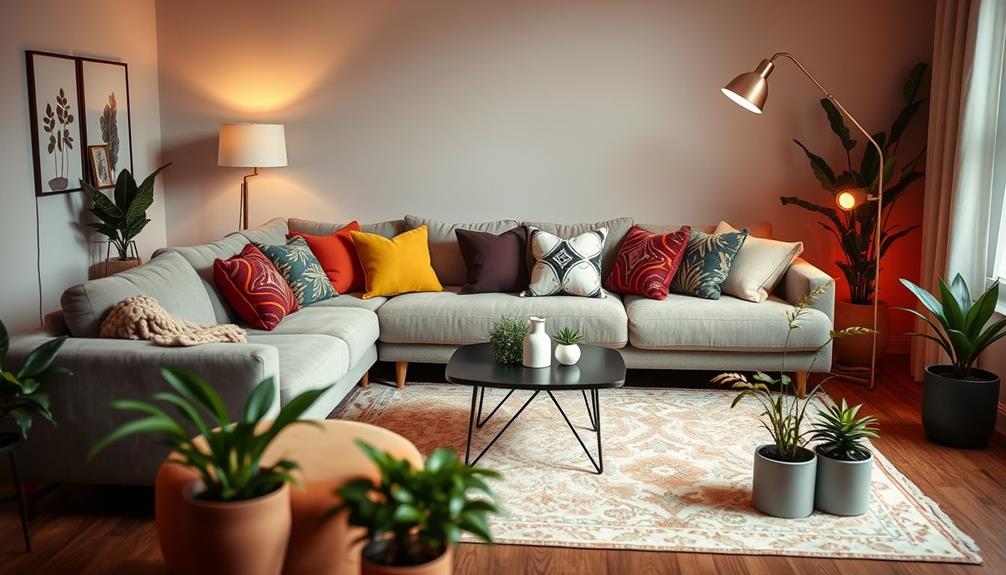To get trade discounts in interior design, you'll need to register as a professional. Gather proof of your business credentials like a business license or tax ID. Some suppliers may require a minimum order amount, typically between $500 and $2,000. Building strong relationships with vendors can also lead to better discounts and terms. Attend trade shows and join industry organizations to expand your network and access unique products. With the right preparation and connections, you can reveal significant savings. There's much more to discover about maximizing your benefits and steering through the application process efficiently.
Key Takeaways
- Register as a professional with proof of business, such as a business license or tax ID, to access trade discounts.
- Build strong vendor relationships to negotiate better terms and gain additional savings on bulk purchases.
- Confirm minimum order amounts with vendors, typically ranging from $500 to $2,000, to align with project budgets.
- Attend trade shows and join trade organizations for networking opportunities and exclusive product access.
- Maintain a professional online presence and use business credentials to establish credibility with suppliers.
Understanding Trade Discounts
Understanding trade discounts is vital for any interior designer looking to maximize their profit margins. These discounts typically range from 20% to 50% off retail prices, allowing you to lower material costs considerably. When you purchase in bulk, suppliers offer these trade discounts to incentivize industry professionals like you.
By taking advantage of these opportunities, you can enhance your competitiveness and achieve better profit margins on larger projects.
To access trade discounts, you'll need to be a registered professional, which often requires proof of a business license or tax ID. This guarantees that only legitimate interior designers can enjoy these savings.
Beyond just cost reductions, trade discounts also grant you access to exclusive products and personalized support from vendors, giving you an edge in your projects.
However, eligibility for trade discounts may vary by supplier, so it's important to build and maintain strong relationships with your vendors. Doing so can lead to better terms and additional savings opportunities.
Requirements for Trade Discounts

To access trade discounts in interior design, you'll need to meet specific requirements that verify your professional status. These requirements may include proof of professional accreditation or certification, a business license, or a tax identification number. Once you have met these requirements, you may be eligible to receive discounts on a wide range of products and services, including furniture, fabrics, and professional resources. Many companies that offer trade discounts to interior designers also provide opportunities for networking and professional development, which can be beneficial for advancing career paths in interior design.
First, you'll typically need to provide proof of business, such as a business license or tax ID. This documentation shows vendors that you're a legitimate designer.
Many suppliers require you to open trade accounts, which often have a minimum order amount ranging from $500 to $2,000 to qualify for those discounts.
If you plan to sell tangible goods, a resale certificate may be necessary, allowing you to collect sales tax on your transactions.
Additionally, having a professional email address and a business card can enhance your credibility during the application process.
Some vendors might also ask for supporting documentation, like social media screenshots or project proposals, to further establish your legitimacy and business intent.
Application Process Overview

When you're ready to apply for trade discounts, you'll need to gather the required documentation and credentials, like your business license and Tax ID.
The application submission steps are straightforward, but make sure you understand the approval timeline, which can vary.
Once your application is in, you'll receive notifications to keep you updated on your status.
Required Documentation and Credentials
Securing a trade discount in interior design hinges on providing specific documentation and credentials that validate your business. To kick off the process, you'll need to gather proof of your business identity, which includes your firm's name, address, contact information, and social media channels.
A current business license is essential, along with your Tax ID or EIN, as these establish your business identity and are necessary for opening bank accounts. If you're selling tangible goods, don't forget to apply for a resale certificate to handle sales tax appropriately.
Additionally, many vendors require a minimum order amount, which can range from $500 to $2,000. It's vital to clarify these details with each vendor upfront.
Here's a quick overview of the required documents:
| Document Type | Purpose |
|---|---|
| Business License | Validates your business |
| Tax ID or EIN | Establishes identity |
| Resale Certificate | Handles sales tax collection |
| Vendor ID Number | Identifies your trade account |
The application process usually takes between 48 hours to five business days, during which you'll submit these documents and clarify payment terms.
Application Submission Steps
Begin the application process by gathering all necessary documentation to guarantee a smooth submission.
You'll need to collect proof of your business, a current business license, and a tax ID or EIN to showcase your legitimacy as a designer.
Once you have everything ready, complete the vendor's application form. This form usually asks for details about your company type, payment terms, and sales practices, which help assess your eligibility for trade discounts.
Make sure you're aware of any minimum order requirements, as these can range from $500 to $2,000 depending on the vendor.
After submitting your application form and documentation, expect the review process to take between 48 hours to five business days. During this time, the vendor will evaluate your eligibility.
Once your application is approved, you'll receive a vendor ID number, granting you immediate access to sourcing tools and trade account privileges.
This is your key to taking advantage of the discounts on your purchases, enhancing your design business effectively.
Approval Timeline and Notifications
Once your application for a trade account is submitted, you can expect a review period that typically lasts between 48 hours and five business days.
During this time, it's essential to stay proactive and maintain communication with your chosen vendors. This way, you can clarify any questions or requirements that may arise.
Upon approval, you'll receive a vendor ID number from a sales representative, granting you access to exclusive trade discounts and benefits.
You'll also gain immediate access to sourcing tools and resources, which can greatly enhance your design projects.
Here are a few things to keep in mind during the approval timeline:
- Stay in touch with vendors for updates on your application status.
- Double-check your application for completeness to avoid delays.
- Prepare to celebrate your new trade account status; it opens doors to networking opportunities.
- Utilize the trade discounts effectively to elevate your business operations.
Minimum Order Considerations

Understanding minimum order considerations is vital for interior designers aiming to maximize their trade discounts while managing project costs effectively. Minimum order requirements can vary markedly, usually ranging between $500 to $2,000 depending on the vendor. It's important to confirm these details before placing an order to avoid unexpected costs.
Additionally, some vendors may have reorder minimums, which should be clarified upfront to guarantee future purchases align with your design project budget. Maintaining open communication with vendors about their minimum order policies can help you streamline transactions and avoid surprises.
When planning your purchases, consider both your project budget and the vendor's minimums, confirming you select items that meet all requirements without overspending. Here's a quick reference table to help you:
| Vendor | Minimum Order ($) | Reorder Minimum ($) |
|---|---|---|
| Vendor A | 500 | 300 |
| Vendor B | 1,000 | 500 |
| Vendor C | 1,500 | 750 |
| Vendor D | 2,000 | 1,000 |
| Vendor E | 750 | 400 |
Benefits of Trade Accounts

Having a trade account opens the door to exclusive products that your retail clients can't access, giving you a unique edge in your designs.
You'll also enjoy significant cost savings, with discounts that can make a real impact on your budget.
Plus, these accounts enhance your professional networking, allowing you to build valuable relationships with vendors that can lead to exciting opportunities.
Access to Exclusive Products
Access to exclusive products is one of the most compelling benefits of trade accounts for interior designers. By having a trade account, you gain access to a world of unique items that the general public can't purchase. This not only allows you to offer distinctive solutions for your clients but also enhances your interior design projects.
For instance, incorporating elements from a Cottagecore Home Office can create a serene and cozy workspace that resonates with clients seeking a connection to nature.
Here are some key advantages:
- Specialized Collections: Many vendors provide exclusive lines and limited-edition products only for trade account holders.
- Early Access: You often get to preview and purchase new product launches ahead of everyone else, helping you stay on top of trends.
- Personalized Service: Vendors usually offer you tailored recommendations and dedicated support for sourcing specific items.
- Enhanced Reputation: Accessing exclusive products can greatly elevate the perceived value of your work, improving your standing in the industry.
With these benefits at your fingertips, trade discounts and exclusive products can truly transform your design offerings.
Embrace the opportunities that come with a trade account, and watch your design business flourish.
Significant Cost Savings
Trade accounts not only open the door to exclusive products but also provide significant cost savings for interior designers. By accessing trade discounts that range from 20% to 50% off suggested retail prices, you can dramatically lower your material costs. This reduction in expenses allows you to manage your projects more efficiently and enhances your overall profitability.
Additionally, leveraging architectural solutions can further streamline your processes and elevate your design outcomes.
When you utilize these accounts, the savings can be reinvested back into your business. This reinvestment can create a more competitive pricing structure, helping you attract more clients and increase your revenue stream. Furthermore, these discounts enable you to offer high-quality materials and products at prices that retail customers can't access, giving you a distinct advantage in the market.
Establishing relationships with vendors through trade accounts often results in improved service and support, which can simplify project management. As you build your credibility in the industry, you'll find that these connections foster collaboration opportunities, further solidifying your position as a trusted interior design professional.
In short, trade accounts not only save you money but also enhance your business potential.
Enhanced Professional Networking
Building professional relationships through trade accounts not only boosts your networking opportunities but also enhances your overall design practice. By engaging with vendors, you open doors to numerous benefits that can elevate your career as an interior designer.
Here are some key advantages of joining trade programs:
- Exclusive Discounts: Enjoy savings of 20% to 50% off suggested retail prices, allowing you to manage project costs effectively.
- Access to Unique Products: Gain entry to exclusive materials unavailable to the public, enriching your design options.
- Enhanced Support: Benefit from improved service and timely assistance from vendors, ensuring your projects run smoothly.
- Networking Opportunities: Attend industry events, workshops, and trade shows, expanding your professional relationships and knowledge.
These connections can lead to collaborations and referrals, making your design practice more robust.
As you cultivate these professional relationships, you'll find that your network becomes a valuable asset, providing resources and insights that can greatly benefit your business in the competitive world of interior design.
Sourcing Trade Products

Sourcing trade products effectively can greatly enhance your interior design projects and budget. One of the best ways to start is by visiting multiline showrooms. These spaces offer a variety of brands and products under one roof, making it easier for you to compare options and select what fits your vision.
Attending trade shows is another valuable strategy. Not only do you gain direct access to vendors, but you also have the opportunity to negotiate better terms for trade discounts.
Additionally, joining trade organizations can provide exclusive discounts, resources, and networking opportunities that aren't available to the general public.
Don't overlook online suppliers that cater specifically to design professionals. Many offer dedicated sections for trade pricing, ensuring you can quickly access discounted products.
Connecting With Vendors

Establishing strong connections with vendors is essential for maximizing your access to trade discounts in interior design. When you foster these relationships, you'll not only gain better pricing but also valuable insights into the latest trends and products.
Here are some effective ways to connect with vendors:
- Attend industry trade shows for direct interaction and networking opportunities.
- Create a professional online presence with a well-designed website and active social media accounts.
- Utilize your business credentials, like a tax ID or business license, to show professionalism when contacting suppliers.
- Join trade organizations to access exclusive vendor connections and tailored discounts.
Don't hesitate to reach out to vendors directly via email or phone. Clearly present your business model and potential purchasing volume to increase your chances of securing trade discounts.
Maximizing Trade Discounts

Maximizing Trade Discounts
After connecting with vendors, you'll want to focus on maximizing the trade discounts available to you. Establishing strong relationships through regular communication and attending trade events can lead to better negotiation opportunities for increased trade discounts.
It's also vital to stay informed about industry trends and AI cybersecurity jobs to understand how technology can enhance your business operations. Always research and compare suggested retail prices before making purchases, as this will empower you to leverage your negotiating power and secure favorable terms with suppliers.
Keep a well-organized budget and meticulously track all trade discounts you receive. This will allow you to analyze their impact on your overall project costs and profitability, making it easier to evaluate which vendors provide the best value.
Consider utilizing procurement tools and software to efficiently manage discount tracking, ensuring you capitalize on all available savings for your projects.
Joining trade organizations can further enhance your purchasing power, granting you exclusive access to additional discounts and valuable networking opportunities within the design industry.
The more you engage with vendors and organizations, the more likely you're to secure repeat business, ultimately maximizing your trade discounts and boosting your bottom line.
Ethical Considerations in Discount Use

Maneuvering the world of trade discounts can be tricky, and it's crucial to take into account the ethical implications of their use.
When you use trade discounts responsibly, you not only benefit your business but also support your community.
Here are some key ethical considerations:
- Support local businesses: Using trade discounts responsibly helps sustain local retailers who depend on markup.
- Uphold ethical purchasing practices: Confirm that discounts are used as intended for industry professionals, not general consumers.
- Maintain supplier relationships: Misusing discounts can strain relationships with suppliers, risking access to these programs.
- Encourage healthy competition: Fairness in the market fosters balanced relationships between designers and retailers.
Conclusion
Incorporating trade discounts into your interior design practice can greatly boost your profit margins—studies show that professionals can save up to 30% on materials. By understanding the requirements and building strong vendor relationships, you can access exclusive products and pricing. Don't overlook the ethical considerations in using these discounts; maintaining integrity is key. With the right approach, you'll not only enhance your designs but also grow your business effectively. Start leveraging those discounts today!









